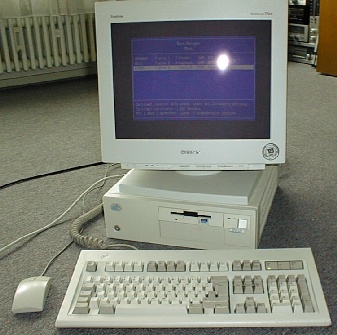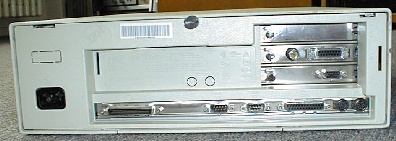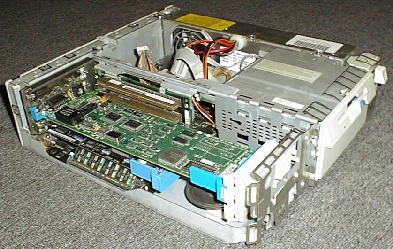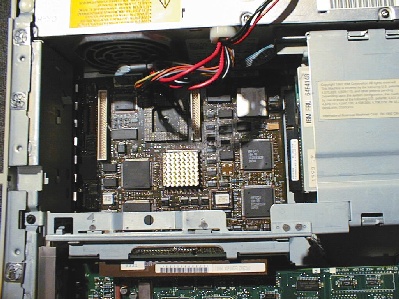
Click here or click onto the photo for a full size version of this picture.
After trying to get the best out of thew 386SX-design of the Model 56/57, IBM finally didn't get around to build a true 486 machine. The result were the models 76 and 77, with the 76 being the 'smaller' desktop machine for workstations and clients. Processor-wise, they offered 486 CPUs between 33 and 100 MHz. The cases are exactly the same - you could swap mainboards between models 56 and 76. Of course, the mainboards are quite different. And last but not least, you get true 32-bit MCA slots....

Click here or click onto the photo for
a full size version of this picture.
A look at the back side shows that the 76 inherited the on-board SCSI from the 56; the plug is the same exotic IBM style, but the innards have become significantly better: the controller has now an own 80188 processor instead of the 80C32 microcontroller used in the 56's SCSI and yields a significantly better performance; it is efectively an on-board version of the 512K cache controller offered as a separate MCA card, just without the cache memory.
A disadvantage of the mainboard of the earlier 76/77 models (also called the 'Bermuda' design) is the lack of an on-board video card (we will see later what ate up so much board space); one has to victimisse one of the three MCA slots fo a card. The Bermudas used an XGA-2 adapter for this purpose; other graphics adapters probably won't work because they depend on the VGA part on the planar for the basic VGA and text modes; the XGA and XGA-2 however bring along their on VGA part.

Click here or click onto the photo for
a full size version of this picture.
Since the 76's case is so similar to the 56, a first look at the innards doesn't show many differences; notable is however an additional 4th SIMM memory socket, allowing up to 32MBytes with 8M modules. The real differences come on the right side of the board:

Click here or click onto the photo for
a full size version of this picture.
At first, it might look as if the processor is missing since the PGA socket is empty; I also thought that at first when I turned on the machine and was quite surprised that the machine still booted. The solution is simple: hidden below the silver heatsink is an i486SX in PQFP case! The socket is there for a 486DX2/66 upgrade which automatically turns off the 486SX. There were also variants of the Bermuda that came off-the-shelf with a DX2, and the space for the 486SX was simply left empty on those. Of course, the two processors consume a lot of board space, and this is probably the reason why IBM was unable to integrate the XGA-2 onto the planar. There even was no space for any sort of L2 cache! Later revisions of the 76/77 (the so-called 'Lacuna' planars) saved board space by using a ZIF socket for the processor, so one could simply throw out the old CPU and insert a new one.
- Processor:
- Intel i486SX @ 33 MHz
- Coprocessor:
- none
- Cache:
- 8K internally in CPU
- Memory:
- 16 Mbytes (options range from 4M to 32M)
- Bus:
- 3 MCA slots (32 bit)
- Interfaces (onboard):
-
- Mouse, Keyboard
- 2 x Serial
- 1 x Parallel
- Floppy (2.88M), allows attachment of up to 3(!) drives
- SCSI (narrow)
- Add-on cards:
-
- 3COM 3C523 Ethernet adapter
- IBM XGA-2 Graphics Adapter
- Operating System(s):
-
- OS/2 Warp Version 3
- Caldera OpenDOS 7.01
- Linux 2.2 (Slackware-based)
- Useful Links: